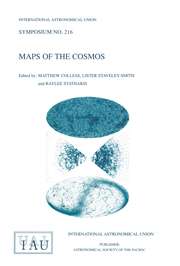Article contents
Properties of galaxy dark matter halos from weak lensing
Published online by Cambridge University Press: 26 May 2016
Abstract
We present the results of a study of the average mass profile around galaxies using weak gravitational lensing. We use 45.5 deg2 of RC band imaging data from the Red-Sequence Cluster Survey (RCS) and define a sample of ~ 1.2 × 105 lenses with 19.5 < RC < 21, and a sample of ~ 1.5 × 106 background galaxies with 21.5 < R < 24.
We constrain the power law scaling relations between the B-band luminosity and the mass and size of the halo, and find that the results are in excellent agreement with observed luminosity–line-width relations. Under the assumption that the luminosity does not evolve with redshift, the best fit NFW model yields a mass M200 = (8.8±0.7) × 1011h –1M ⊙ and a scale radius rs = I6.7+3.7 –3.0 h –1 kpc for a galaxy with a fiducial luminosity of Lb = 1010 h –2LB⊙. the latter result is in excellent agreement with predictions from numerical simulations for a halo of this mass. We also observe a signficant anisotropy of the lensing signal around the lenses, implying that the halos are flattened and aligned with the light distribution. We find an average (projected) halo ellipticity of 〈e halo〉 = 0.20+0.04 –0.05, in fair agreement with results from numerical simulations of CDM. Alternative theories of gravity (without dark matter) predict an isotropic lensing signal, which is excluded with 99.5% confidence. Hence, our results provide strong support for the existence of dark matter.
Information
- Type
- Part 13: The Shapes and Extents of Dark Halos
- Information
- Symposium - International Astronomical Union , Volume 220: Dark Matter in Galaxies , 2004 , pp. 439 - 445
- Copyright
- Copyright © Astronomical Society of the Pacific 2004
References
- 3
- Cited by

